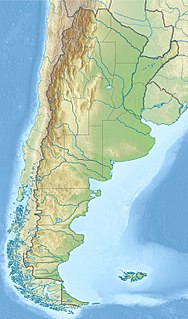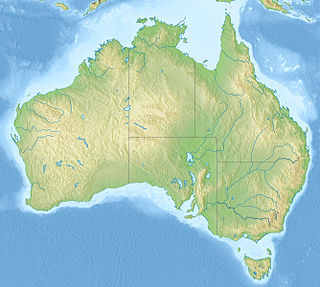
Rhabdodon is a genus of ornithopod dinosaur that lived in Europe approximately 70–66 million years ago in the Late Cretaceous. It is similar in build to a very robust "hypsilophodont", though all modern phylogenetic analyses find this ("Hypsilophodontia/tidae") to be an unnatural grouping, and Rhabdodon to be a basal member of Iguanodontia.
Argiles et Grès à Reptiles Formation is a French geologic formation in the département of Var preserving the remains of several types of dinosaurs and other extinct organisms.
The Grès et sables piquetés is a geological formation in Haute Marne and Meuse Departments, France, that dates back to the Early Cretaceous. Dinosaur remains are among the fossils that have been recovered from the formation.
The Artoles Formation is a geological formation in Teruel and La Rioja, Spain whose strata date back to the Early Cretaceous. Dinosaur remains are among the fossils that have been recovered from the formation.
The Qingshan Formation is a geological formation in Shandong, China, whose strata date back to the Early Cretaceous. Dinosaur remains are among the fossils that have been recovered from the formation.
The Ejinhoro Formation is a geological formation in Inner Mongolia, north China, whose strata date back to the Early Cretaceous period (Aptian/Albian age.
The Grès supérieurs Formation is a geological formation in Laos whose strata date back to the Early Cretaceous. Dinosaur remains are among the fossils that have been recovered from the formation. It is equivalent to the Khok Kruat Formation of Thailand. Dinosaur remains are among the fossils that have been recovered from the formation.

The Cerro Barcino Formation is a geological formation in South America whose strata span the Early Cretaceous. The top age for the formation has been estimated to be Albian. Earlier estimates placed the formation until the Campanian.

The Allaru Formation, also known as the Allaru Mudstone, is a geological formation in Queensland, Australia, whose strata date back to the Early Cretaceous. Dinosaur remains are among the fossils that have been recovered from the formation.

The Griman Creek Formation is a geological formation in northern New South Wales and southern Queensland, Australia whose strata date back to the Albian to Cenomanian. Dinosaur remains are among the fossils that have been recovered from the formation.

The Wonthaggi Formation is a geological formation in Victoria, Australia whose strata date back to the Early Cretaceous. It is part of the Strzelecki Group. Dinosaur remains are among the fossils that have been recovered from the formation. It is equivalent to the Eumeralla Formation.

The Eumeralla Formation is a geological formation in Victoria, Australia whose strata date back to the Early Cretaceous. Dinosaur remains are among the fossils that have been recovered from the formation. It is equivalent to the Wonthaggi Formation.

The Aguja Formation is a geological formation in North America, exposed in Texas, United States and Chihuahua and Coahuila in Mexico, whose strata date back to the Late Cretaceous. Dinosaur remains are among the fossils that have been recovered from the formation.
La Bocana Roja Formation is a geological formation in Baja California, Mexico whose strata date back to the Late Cretaceous. Dinosaur remains are among the fossils that have been recovered from the formation.
The Gres de Labarre Formation is a geological formation in France whose strata date back to the Late Cretaceous. Dinosaur remains are among the fossils that have been recovered from the formation.
The Marnes Rouges Inferieures is a geological formation in Aude, France whose strata date back to the Late Cretaceous. Dinosaur remains are among the fossils that have been recovered from the formation.
The Densuş-Ciula Formation is a geological formation in Romania whose strata date back to the Late Cretaceous. Dinosaur remains are among the fossils that have been recovered from the formation.

The Marília Formation is a geological formation in Goiás, Minas Gerais, and São Paulo states of southeastern Brazil. Its strata date back to the Maastrichtian, and are part of the Bauru Group.

The Bissekty Formation is a geologic formation which crops out in the Kyzyl Kum desert of Uzbekistan, and dates to the Late Cretaceous Period. Laid down in the mid to late Turonian, it is dated to about 92 to 90 Ma.
The Calizas y margas de Xert Formation or Xert Formation is a Cretaceous period geologic formation in Spain.








